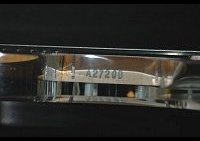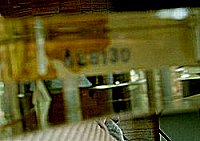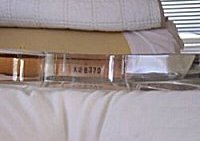
As seen upper left & right, the base of the neck is also where the instruments serial numbers can be found. It is stamped into
the bass side of the neck in a black ink or dye and once the instrument has been strapped on, or otherwise held in the
playing position, one can easily see the number by merely looking straight down and through the clear acrylic body and
onto this portion of the neck. The serial numbers always ran consecutively, and according to Dan the actual production
models "began with number 100."
Using this information, the guitar neck numbered A204D is actually the 104th guitar off the standard production line. According
to Dan, apparently anything prior to A100D was some kind of prototype, or was made at a time prior to the actual production line. It's
unlikely that there were 99 prototypes - more likely the number was pushed up to where the actual production number started at 100.
The neck with the serial number A2357D R seems rather unique, and Dan informed me that "any serial number followed by the letter R was a
reject much like a Gibson factory second. It usually refers to some minor flaw in the cosmetics of the instrument". While not enough to affect
the structural ability or the playability, the guitar had some minor cosmetic type flaw that was not up to Dan's standards. Such instruments were
either fitted with a different neck, or, more commonly - they were sold for less.
At upper left a neck on one of my guitars, while at right, another guitar with a higher serial number - A2754D which also has the 'R' identifier telling us that it
too, is a reject neck which made the instrument sell for less. The serial number on this instrument is particularly interesting in that within 100 or so more models
the Dan Armstrong · Ampeg instruments would come to an end.
At upper left, the serial numbers on the bass instruments begin and end with Dan's initials. My bass guitar seen here has a serial number of D1255A
which makes it an early 1970 model. The bass on the right has a much larger, and thus later serial number of D2590A which makes it a 1971 model.
As for the guitar, and seen below, they too began and
ended with Dan's initials. However, in the case of the guitar necks the initials are reversed. When asked about it all Dan
replied "I decided to include my initials along with the serial numbers on the necks and if I remember correctly, we had
a run of bass necks right away and so we used this numbering-lettering convention on them. It all worked fine until we started
to do some guitar necks and thats when we discovered that we would be duplicating serial numbers. So we had to quickly come up
with a different convention for the guitar models. So I just decided to used my last initial first".
 photo courtesy of Elon Coats
photo courtesy of Elon Coats
|
 photo courtesy of John McCutchan
photo courtesy of John McCutchan
|
 photo courtesy of Craig Johnson
photo courtesy of Craig Johnson
|
At upper left, and as can be clearly seen, a 1971 Dan Armstrong guitar with a fairly high serial number A2720D
which happens to belong to my friend Elon. This instrument was getting close to the end of the production run in
1971. As seen at center, another Dan Armstrong guitar with a very high serial number A2813D
belonging to John McCutchan which was produced even closer to the end days of production. Everything that Dan and
Ampeg had learned about the manufacturing these instruments were featured on these instruments.
As seen upper right, and belonging to Craig Johnson, this Dan Armstrong instrument features the highest serial number
I have seen to date A2837D which almost certainly was produced extremely close to the end of the
production run of these instruments. When asked about the actual number of instruments produced from 1969 to 1971 Dan
had said "around 6,000 guitars and basses" which I originally took to mean 6,000 guitars and 6,000 basses.
But what I believe he actually meant was around 3,000 guitars and around 3,000 basses - making for a total of roughly
6,000 instruments overall that were produced - which would be fairly close, though serial numbers higher than these
shown here have yet to surface on either the guitar or the bass models. However, if you figure in a fudge factor and
remember that the first 100 instruments were experimental, one can say that roughly 3,000 of each were made.
But even with serial numbers at your disposal, some Dan Armstrong instruments simply defy description, usually as a
result of the time frame, &/or the circumstances they were manufactured under. Again, and according to Dan "any
instrument made prior to A100D was a prototype or anything made before the actual production run began."
After hearing Dan say that I became curious if any instruments were made prior to, or after, the point where they
stamped the necks with a serial number. It seemed likely that some instruments may have slipped through the proverbial
'cracks' in the system, but I had never actually seen one.
My curiousity was satisified the day I heard from Mr. Paul Q. Kolderie, a record producer and engineer who sent in
photos of his Dan Armstrong guitar that somewhat fit my theory and who provided the photos seen below.
As can be seen in the upper left, this guitar features all the usual hardware of later Dan Armstrong guitars. However,
as the upper right reveals this guitar is fitted with a neck that has no serial number on it whatsoever. In fact, the
only distinguishable feature on this neck are the letters 'ACF' or maybe 'ALF' which
is hand written on the bottom, or the base of the tongue on the neck rather lazily or haphazardly, not like what one
would write if one was trying to be extra careful. On the contrary, it looks rather scribbled in there.
Was this a particular neck picked out by an Ampeg employee with their initials written in there? It would seem unlikely,
for Dan personally inspected every instrument before it left the factory. This was an agreement made at the very beginning
and one that Ampeg apparently came to regret over time as they felt that Dan's visits were a bit too sporadic for
production purposes. Guitars would be ready to ship but they had to wait for Dan's OK. Toward the end, much of the
reason for Dan's fewer visits was due to the strained relationship he now had with Ampeg management over the SVT and
other V series amplifiers.
Nevertheless, Dan eventually showed up, and being he personally checked over each & every instrument to his
satisfaction, it would seem unnecessary for anyone to pick & choose a neck beforehand, and even if they had - why
would it not have a serial number?
Perhaps the answer lies with the rest of the hardware on this guitar. As stated earlier, it has all the features of a
latter day Armstrong. By mid to late 1971 Ampeg had closed down the production of the Dan Armstrong guitars and the news
came as quite a shock to the employees on the production floor at Ampeg. As former Ampeg engineer Steve Constantelos stated
"most of us were surprised when we came to work one day and were told that production of these instruments had come to an
end, and to cease operations."
He continued, saying "we completed any instruments that we could and everything else was sold to a local
dealer in New Jersey - I can't remember his name but I bought some bass parts from him." I told him "that
would be Lou Rose from Lou Rose music" and instantly he stated "that's the guy - that's the name - he was a
good friend of Dan's or something and he bought out everything."
Steve also talked about Ampeg's employees taking home any left over pieces of acrylic lying around. Apparently smaller remnants of
it were free for the taking and Steve said "we made lamps and all kinds of things out of it around here." But
what he said earlier had my total attention..... "we completed any instruments that we could"....
for it is a phrase that could well serve as an epitaph for the Dan Armstrong instruments, and it may well
offer us the best clue as to the possible origin of this particular instrument. As though waiting its turn in
line on the production floor, it may have been quickly completed and made ready to ship - as history turned a page,
and the Dan Armstrong · Ampeg clear guitars and basses met the end.
menu
Names and images are TMand © Dan Armstrong / Ampeg. All rights reserved.
All other names and images are TMand © of their respective owners. All rights reserved.
| | |

